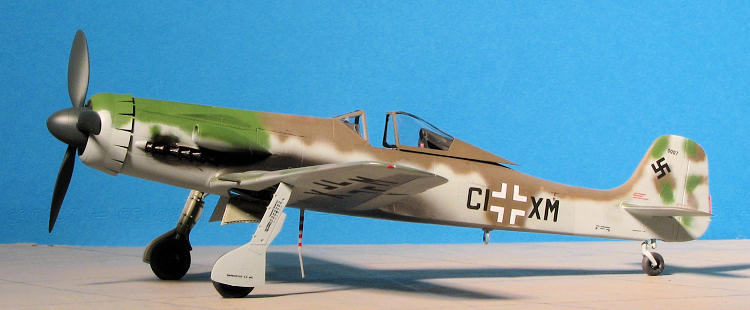
Hobby Boss 1/48 Ta-152C-0
| KIT #: | 81701 |
| PRICE: | $31.99 SRP |
| DECALS: | Two options |
| REVIEWER: | Scott Van Aken |
| NOTES: | New tool kit |

| HISTORY |
The Focke-Wulf Ta 152 was a World War II German
high-altitude fighter-interceptor. The Ta 152 was a development of the
Focke-Wulf Fw 190 aircraft, but the prefix was changed from "Fw" to "Ta" to
recognize the cont ributions of Kurt Tank who headed the design team. The number
152 was chosen in the German air ministry's list of numbers allocated to German
aircraft companies, and was not related to the designer's previous projects or
achievements. It was intended to be made in at least three versions—the Ta 152H
Höhenjäger
("high-altitude fighter"), the Ta 152C designed for slightly lower-altitude
operations and ground-attack using a different engine and smaller wing, and the
Ta 152E fighter-reconnaissance aircraft with the engine of the H model and the
wing of the C model.
ributions of Kurt Tank who headed the design team. The number
152 was chosen in the German air ministry's list of numbers allocated to German
aircraft companies, and was not related to the designer's previous projects or
achievements. It was intended to be made in at least three versions—the Ta 152H
Höhenjäger
("high-altitude fighter"), the Ta 152C designed for slightly lower-altitude
operations and ground-attack using a different engine and smaller wing, and the
Ta 152E fighter-reconnaissance aircraft with the engine of the H model and the
wing of the C model.
The first Ta 152H entered service with the Luftwaffe in January 1945. While total production—including prototypes and pre-production aircraft—has been incorrectly estimated in one source at approximately 220 units, only some 43 production aircraft were ever delivered before the end of the European conflict.These were too few to allow the Ta 152 to make a significant impact on the air war. As far as can be confirmed by photographs, only one Ta-152C-0 was constructed and its operational use is unknown.
| THE KIT |
This is not the first injected styrene Ta-152C to be produced in 1/48 scale. In the late 1980s or early 1990s, Trimaster released one that had a resin wing. It was both expensive and the resin was not very good as the fit was terrible according to those who built one. This same kit but without the photo etch and resin bits was released later by DML and yet again by Dragon. Dragon re-issued this kit not more than a few months ago. Now we have a brand new tool version from Hobby Boss.
The molding
on this one is exactly what one would expect from a new mold kit. Crisp and
clean engraved panel lines along with none of the depressed rivet detail that
infuriates some modelers. The kit has a well appointed cockpit with raised
detailing and decals for the instrument panels and consol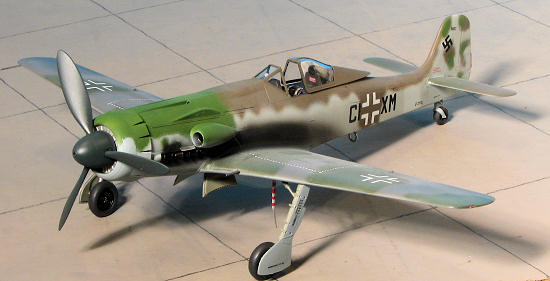 es. Part of the photo
etch fret (most of it actually) is used for belts, rudder pedals and the like.
The area behind the cockpit also gets a photo etched pieces. A two piece canopy
allows interior detailing to be viewed.
es. Part of the photo
etch fret (most of it actually) is used for belts, rudder pedals and the like.
The area behind the cockpit also gets a photo etched pieces. A two piece canopy
allows interior detailing to be viewed.
This kit includes an open accessory section that can be viewed through the wheel wells, just like on the real plane. There are two upper engine cowlings with the lone difference being the size of the bulge next to the supercharger intake. The C-0 version gets the smaller of the two. This leads me to believe that Hobby Boss will undoubtedly release a long wing Ta-152H version and perhaps even a family of FW-190Ds. Another option is to have open or closed cowl flaps.
Separate ailerons and flaps and rudder are included and while it would have been nice to have the elevators separate as well, these are molded in the neutral position. Complete wing cannon are provided, though little will be seen when done. Finally, a bit of an oddity is that the exhaust are split into upper and lower halves. Not sure why, but there it is.
Markings are provided for two planes. One is the prototype 152C-0 and the other is a set of spurious markings for Blue 13 with JG 301. Hobby Boss as a full color painting and markings guide that offer colors in many brands of paints and also their RLM equivalents. Decals are very well done and my experience with them has always been positive.
| CONSTRUCTION |
This one starts, as do most of my aircraft builds, with my
searching out sub-assemblies. This meant the wheels, interior, and the engine
accessory section. I glued in most of the interior bits that would be RLM 66.
The kit comes with a photo etch fret for the belts and the rudder pedals as well
as the section behind the cockpit. However, I didn't see any major improvement
over the 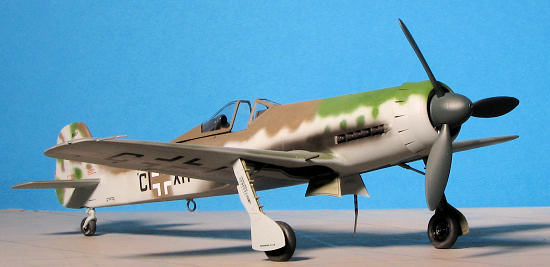 plastic bits for the latter so you have the option. For the belts I
used Eduard pre-painted belts. These seemed to be a bit less wide than the ones
provided on the kit's fret and I didn't have to paint them.
plastic bits for the latter so you have the option. For the belts I
used Eduard pre-painted belts. These seemed to be a bit less wide than the ones
provided on the kit's fret and I didn't have to paint them.
The accessory section was quickly built up. I had some trouble getting the supercharger piping in place, but fortunately, installed it before all the glue had dried so was able to slip it in. There are seams that need dealt with on some of the parts, but careful planning and scraping will make taking care of these rather easy. This whole assembly was painted Steel and I used Burnt Metal on the supercharger piece, these paints from the Alclad II line.
While the decals were snuggling over the various instrument
panels, I assembled the wings. The back of the wheel well is also the wing spar.
Two cannon fit behind this with the barrels sticking through the wheel wells.
The cannon are small models in and of themselves, but since I didn't see how you
could actually view them once the wing was built, I just used the main part.
There are a couple of wheel well frames to glue into each well and then this is
glued into the lower wing. Fit is superb. Meanwhile, I cemented the tail wheel
gear and retraction link in place. This link is tied to the step and so fragile
are the parts that cutting the link away broke the step into several pieces. I
should mention that all the wheel wells and struts were painted RLM 02. Now to
be frank, it may well be that these areas were not painted since this was a very
la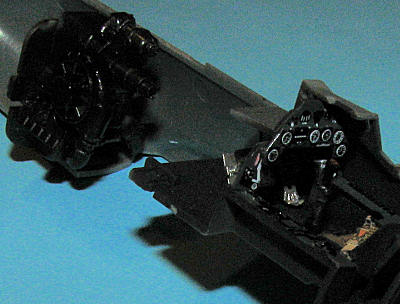 te war plane, but I did so anyway. The upper wing sections were glued in place
and the seams puttied and later sanded down.
te war plane, but I did so anyway. The upper wing sections were glued in place
and the seams puttied and later sanded down.
The cockpit instrument panel assy was glued in place and I ended up using the etched rudder pedals as when I went to cut one off the sprue, it broke in half. Thank goodness for the etched option. These were painted silver as photos showed pedals were normally unpainted metal. The accessory section and the cockpit were glued into the right fuselage half as was the tail wheel strut. Then the halves were glued together. The fit of the cockpit and accessory section are superb, but you need to be sure to remove all the sprue nubs from the cockpit floor section to get a good fit I found that the top of the fuselage fit better than the lower section, which needed filler. During this time, I also attached the upper cowling (small supercharger bulge) and the plastic section that fits behind the seat. To this section was later attached the shoulder straps of the harness.
Meanwhile, the supercharger intake was cleaned up and glued in
place as was the wing. I glued just the front and rear attachment point on this
a t first as there is a gap on the upper wing root that will need to be attended
to and I felt it better to get that done before attacking the gap. I then
installed the ailerons and flaps as well as the rudder and horizontal stabs. Fit
was equally good. For the last item before painting, I glued on the forward
cowling, choosing the one with the open cowl flaps. I'm just a sucker for that
look as I like it. You can attach the flaps down, but you'll first have to
remove the ejector marks from the flap and the underside of the wing. I found
only a couple of photos of 152s with the flaps down while parked so it seems
they were mostly up. I also trimmed back the prop a bit. Some
correspondence indicated that the kit's prop is more for the H version and
photos of the extant C model
showed a thinner blade with a more pointed tip. Though probably not really
evident, in this photo, the lower left blade is untouched while the others have
been modified.
t first as there is a gap on the upper wing root that will need to be attended
to and I felt it better to get that done before attacking the gap. I then
installed the ailerons and flaps as well as the rudder and horizontal stabs. Fit
was equally good. For the last item before painting, I glued on the forward
cowling, choosing the one with the open cowl flaps. I'm just a sucker for that
look as I like it. You can attach the flaps down, but you'll first have to
remove the ejector marks from the flap and the underside of the wing. I found
only a couple of photos of 152s with the flaps down while parked so it seems
they were mostly up. I also trimmed back the prop a bit. Some
correspondence indicated that the kit's prop is more for the H version and
photos of the extant C model
showed a thinner blade with a more pointed tip. Though probably not really
evident, in this photo, the lower left blade is untouched while the others have
been modified.
| COLORS & MARKINGS |
I put some tape over the cockpit opening and started on the
underside colors. First the fuselage and wings were painted Alclad II Aluminum
and when dry, a section as shown in the instructions was masked off and the rest
of the underside painted RLM 76. I also painted the upper wings with RLM 75,
both these colors being Testors. Now this plane is a nice mix of colors with
bits c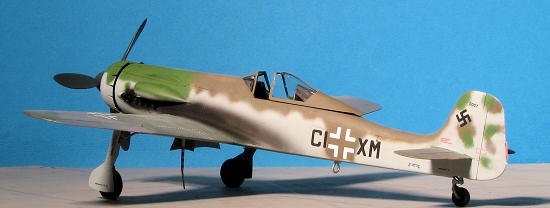 oming from apparently other places and pre-painted for assembly. The
instructions do not correctly identify all the colors if one studies the
painting guide. It leaves off the RLM 83 bright green and the RLM 81 brown green
that are used on the fuselage and part of the tail planes. Those two colors were
from my meager Aeromaster Enamels stash, but I'm getting ahead of myself.
oming from apparently other places and pre-painted for assembly. The
instructions do not correctly identify all the colors if one studies the
painting guide. It leaves off the RLM 83 bright green and the RLM 81 brown green
that are used on the fuselage and part of the tail planes. Those two colors were
from my meager Aeromaster Enamels stash, but I'm getting ahead of myself.
With the first two shades applied, I masked off the underside of the model and some of the tail. I also glued on the windscreen and assembled the canopy before tacking it in place. Next, I sprayed the cockpit area RLM 66 and did the RLM 82 dark green areas which included the entire tail planes at this time. Thanks to the use of lacquer thinner, I was ready for the third painting session of the day and using Aeromaster enamels, painted on the RLM 81 and RLM 83. This now provided the base areas. Next would be the mottling and touch up. As you can see, this is a very colorful aircraft in terms of the different camouflage colors used.

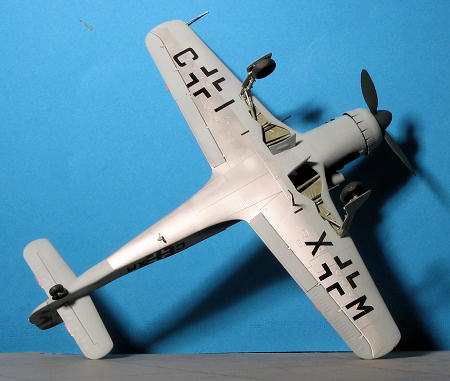 Next the mottling was applied. Even though there isn't a lot
of it, there was a lot of back and forth with the colors to get things to where
I found them acceptable.
Next the mottling was applied. Even though there isn't a lot
of it, there was a lot of back and forth with the colors to get things to where
I found them acceptable.
With that complete, the kit returned to the work bench to have the landing gear installed prior to giving it a gloss clear coat. One has to take care when gluing in the gear as the attachment points are not positive lock types and it is important that one get the angle just right. I also took this time to install the inner gear doors and glue on the tail wheel.
With the clear coat applied, I started putting on the decals. These are very thin and much care needs to be taken as they easily fold on themselves and tend to stick on the first place they are put. Eventually I got them all on and with minimal silvering, which is pretty amazing of itself as some of those went down on matte surfaces.
| FINAL CONSTRUCTION |
Now that the decals were installed, I started gluing on all
the bits and pieces I'd earlier left off. The exhaust were glued in after
painting with Alclad II 'Exhaust Manifold'. I have to say that despite being two
piece exhaust, they turned out well. The small brass piece just below the
supercharger intake was forgotten earlier in the build and now glued in place.
Same goes for the wheels and gear doors. To get the sit right, the wheels were
tacked on the axle with clear paint and then it was all place on the platen of
my scanner to be sure it was flat. Then a drop of super glue was placed on the
axle when all was dry and it held well. Lower wing
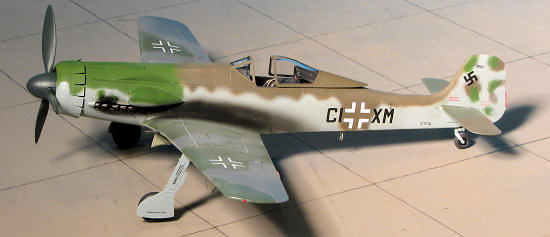 radio
antenna was painted with red stripes, the pitot tube was glued on and the kit
was taken for its last paint.
radio
antenna was painted with red stripes, the pitot tube was glued on and the kit
was taken for its last paint.
In this case, it was Alclad II Jet Exhaust that was sprayed on the side. Normally, I use pastels for this, but through caution to the wind and used paint. Exhaust stains from late war avgas were intensely black due to the quality of the fuel so it worked out OK. The entire airframe was then given a matte clear using my usual Future and Flat Base, the prop pushed on, the formation lights painted, DF loop attached, , the canopy section glued in place and it was done. No step as I'd destroyed that earlier, but I don't think many will miss it.
| CONCLUSIONS |
This is an excellent kit. I've not built the Dragon version in this scale, but this one has to be easier to build and gave me minimal problems. I'm not 100% pleased with my painting, but blame my air brush for that. Regardless, the overall model really looks nice and as one who likes long nose Focke-Wulfs it adds a lot of interest to the collection.
 As a note,
apparently FW-190 experten, Jerry Crandall, has a quartermaster's log or has
read such a log from the last weeks of the war that state that JG 301 had two
Ta-152C-1 aircraft on hand with the stabschwarm. Hence the optional 'Green 13'
markings provided in the kit. No photos of these planes have appeared, but if
one believes what is in the record, there was more than one of these planes
flown late war (at least flown from the factory to the unit). They probably sat
there with empty fuel tanks, but it seems they did exist.
As a note,
apparently FW-190 experten, Jerry Crandall, has a quartermaster's log or has
read such a log from the last weeks of the war that state that JG 301 had two
Ta-152C-1 aircraft on hand with the stabschwarm. Hence the optional 'Green 13'
markings provided in the kit. No photos of these planes have appeared, but if
one believes what is in the record, there was more than one of these planes
flown late war (at least flown from the factory to the unit). They probably sat
there with empty fuel tanks, but it seems they did exist.
Back at the Hobby Boss kit, I have to give it a two thumbs up and can easily recommend it over any other kit of this plane, at least in 1/48. For those wondering, total build time, from opening the box to removing the masking from the clear bits was exactly a week.
| REFERENCES |
http://en.wikipedia.org/wiki/Ta-152
April 2011
Thanks to Squadron Products for the review kit. Get yours today at your favorite retailer.
If you would like your product reviewed fairly and quickly, please contact me or see other details in the Note to Contributors.